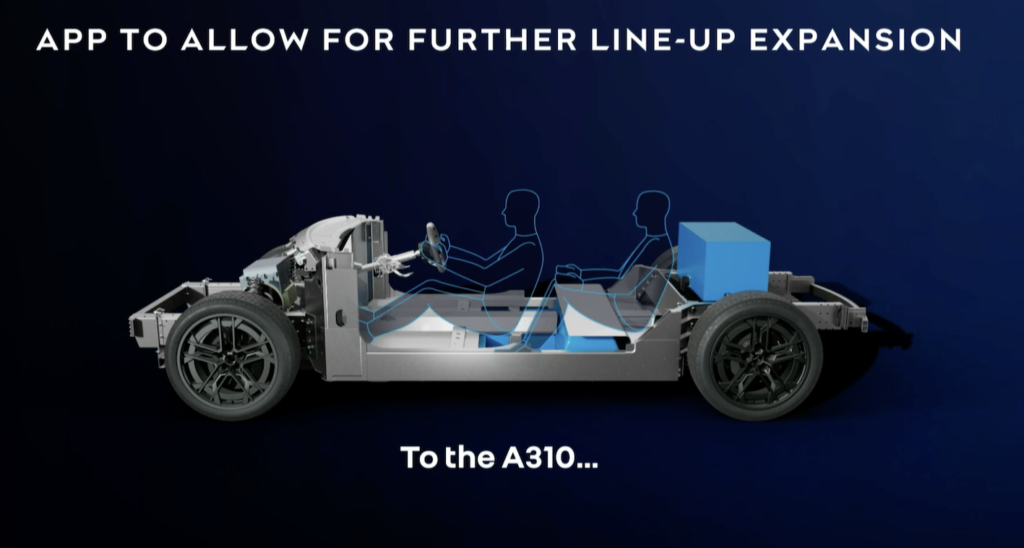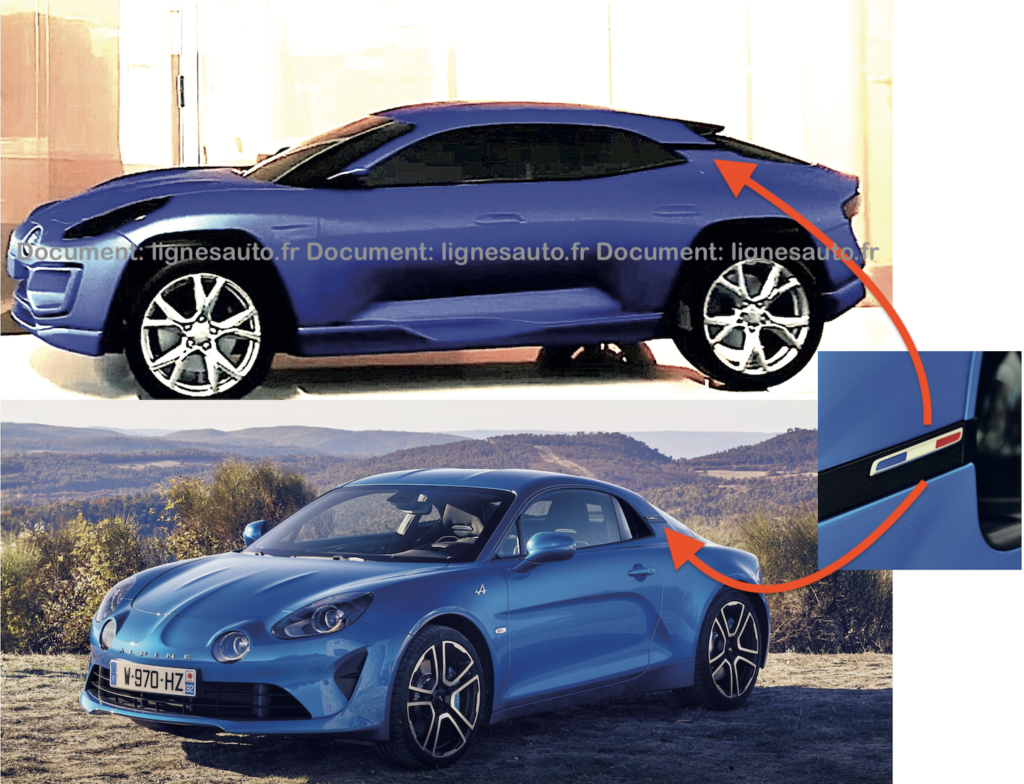

INDEED: your LIGNES/auto site offers you the chance to download the bilingual PDF of the “Alpine dossier” with this interview and an archive subject. It’s easy to read on a computer, just like a paper magazine article, and is a pleasant addition to the site. It’s free and here:
Once the Alpine brand has unveiled its entire product plan, i.e. 7 models between now and 2028, it will be clear that almost half of them will be crossovers! The C-XO GT in the compact segment, the D-XO GT in the road-going segment and the E-XO GT in the top-of-the-range segment will bring to three the number of models based on the crossover concept.

They will form part of Alpine’s ‘Lifestyle’ line, and the company is making no secret of the fact that the aim is to create volume. The small A290 will be added to this line-up. Opposite, the sports car line with the future A110 in coupé and roadster versions, and the 2+2-seater which will be called the A310. If we add that the roadster will be a derivative of the A110 and that the E-XO GT will be a long version of the D-XO GT, we can safely say that half of the Alpine range – in terms of volume at any rate – will be based on the crossover concept.

As you can see from the diagram above, the ‘sports’ section will be based on three new models, based on the new ‘APP’ platform, which stands for ‘Alpine Performance Platform’. This architecture is totally modular and will accommodate three models: the A110, A110 Roadster and A310. The latter, shown below, will have an increased wheelbase and track, as well as a second row for two passengers. However, the APP platform will not be used for the C-XO GT crossover, which will borrow its own from the Nissan Ariya.

So there’s no need for fans of the historic brand to flagellate themselves over the arrival of the crossovers, which will be launched from 2025 for the C-XO GT, and until 2028 for the two crossovers with a (very) international vocation. The sporty silhouettes will certainly be there. Below is the profile of the future A110 unveiled at the product plan presentation. Should we trust it? We’ve compared it with the profile of the original Berlinetta. The future 100% electric car will benefit from the short version of the APP. The roof is very bulbous…

Let’s close the garage door on Alpine’s future sports cars and open the door on its life-style crossovers.Why is the Alpine brand turning to this type of silhouette?The answers are obvious.Firstly, if Alpine wants to become and remain a profitable brand while remaining part of the Renault group (by which I mean, without being sold…), it needs to achieve a break-even point, which necessarily requires volume.And it’s not the future A110 and A310 that will provide this solid base, but rather the crossover silhouettes, such as the very forthcoming C-XO GT below.

Secondly, the idea of an Alpine that mixes genres, crosses concepts and dares to call itself a crossover is not new in itself.In fact, it’s over…forty years old!Here’s a brief summary of these Alpine projects, which went far beyond the simple idea of a light, sporty and compact product!With an exclusive that shows that the forthcoming C-XO GT compact crossover was not born yesterday!
READ THE INTERVIEW WITH DESIGNER ADRIEN ACQUITTER (“From Ferrari to Alpine”) here : http://lignesauto.fr/?p=30278
1979: the SUV VVA: Véhicule Vert Alpine (Green Alpine Vehicle)

While the Matra Simca Rancho, born in 1977, had not yet celebrated its second birthday, Renault stylists came up with an Alpine-badged leisure vehicle in 1979. This was the VVA: Véhicule Vert Alpine. Michel Jardin and Marcello Gandini were responsible for the styling of the first proposals. Jardin opted for a design that provided plenty of light on board. More than just a direct counterweight to Matra, the VVA project aimed to find a business for the Alpine factory in Dieppe, as the numerous development projects for the range had all met with setbacks. “We chose Alpine because, with their light and inexpensive industrial resources, it would have been possible to test the market without too heavy an investment. This Alpine was to have four-wheel drive, unlike its Matra Simca rival. In 1980, the project changed direction…
1980: the VGR: Alpine pulls out of the project

This new approach, which aimed for a more international vehicle with a more distinctive design, was led by some fine Italian names, not least Marcello Gandini. He proposed two variants of the VVA project, which lost its “Alpine” name to become the VGR (Véhicule de grande randonnée). Mario Bellini studied a plush interior for Gandini’s second proposal, which had a very Range Rover feel to it. But AMC entered the fray when it became part of Renault, and Bernard Hanon, the boss, had other plans for the Jeep range. The VVA and VGR will remain prototypes.
2005: the W16 project, a compact Renault-Sport “Alpine” SUV

Alpine, which Louis Schweitzer killed off in 1995, is still very much alive in the minds of many designers at the brand new Technocentre in Guyancourt, where the Renault group’s design offices are based. Although the Renault-Sport label has replaced the Alpine brand, it goes without saying that many people live and breathe Alpine every day! The small 2+2 seater mid-engined SUV designed in 2005 under the code name W16 single-handedly invented the idea of a compact crossover. It was designed for Renault-Sport by designers who imagined an Alpine. One that would have revived the legend.

This crossover project opens up new horizons. It should be remembered that the Berlinette Z11 (the potential return of the Alpine name to the Renault group) had been close to production. And this sports coupé from the 2000s, which should have been presented in 2001, already had a look that was very different from the idea people had at the time of Alpine’s return to mass production (see below). It was already a sort of ‘mix of genres’. A crossover, then… Unfortunately, this Z11 project, like the W16, never came to fruition. But Alpine lovers have not said their last word.

2011: the “ZH-25” was to become Alpine’s first crossover
Codenamed ZH-25, the second concept car from the Laurens van den Acker era in 2011 (after the DeZir coupé, which also featured the Alpine logo for a time), hides the Renault Captur concept car. As you can see from the project drawing below, the concept car team is once again attempting to apply the Alpine logo. This design for a dynamic coupé crossover, with its round headlamps set between two sharp headlights, could well have been part of the Alpine range.

But the Alpine range will no longer exist in 2011, even if there is no shortage of projects in-house. The feud between the enthusiasts of the arrowed A and those of the Renault-Sport label is not making things any easier. In this internal duel, Laurens van den Acker decided that it was too early to brand one of the concept cars with the Alpine logo. The ZH-25 will therefore become the Renault Captur in 2011, with an SUV derivative of the Clio that will borrow its name from the concept, but not its dynamism. The 2011 Captur already hides the genes of a potential Alpine crossover… But that’s just a postponement!

2018: the A110 SUV
EXCLUSIVE DOCUMENT
Seven years later, as the Alpine project finally moves towards the production of a descendant of the Berlinette, ambitions are being stepped up a notch. Behind the scenes, people knew that the sports coupé alone would not allow the brand to survive. However, the boss at the time – Carlos Ghosn – had no intention of creating an Alpine ‘range’. Still less did he imagine the name becoming a brand in its own right alongside Renault and Dacia…

So in 2017, the next-generation Alpine A110 was unveiled after a first attempt at a front-engined Nissan ZX-based Berlinetta had failed. It was the W19 project dated 2007 already published on our site (below).

With the new draft A110 of 2017, the design is accurately projected in a future where the theme of “SUV” will please and, associated with the name of Alpine, imagines a “dynamic SUV”. This crossover version, of which here is an exclusive model, cannot be precisely dated, but the rear quarter panel, which is close to that of the production A110, seems to attest to the fact that it was produced almost at the same time as the A110 revival project.

The silhouette of the A110 is recognisable, with a bow (in 1) featuring two additional headlamps, while the bonnet is almost flat, no doubt to accommodate the powertrain (was there already talk of 100% EV? Probably not by now…), a very long wheelbase and four doors (in 3). The body height has been raised and the aerodynamics have been applied to the rocker panels (in 2). The stature is high, while at the rear we find the characteristic design of the A110 (in 4), notably on the pillar above the wheel and the inclination of the rear window. In 5, the design appears to be very similar to that of the A110 coupé, with only the lights also being raised. For the time being, the Alpine crossover will go no further than this mock-up…

2020: the Alpine Sport X, a fleeting temptation

Following the announcement of the Renaulution plan and the three 100% electric models (A290, C-XO GT compact crossover and the future A110), the very recent A110 combustion engine knows that its days are numbered. There’s no question of a convertible version, even though a fringe of customers are demanding one, and there’s no question of a renewal on a platform designed exclusively for a combustion powertrain.

But as this marvellous machine had to be kept going for a few more years, a number of upgrades to the powertrain, finishes and performance were proposed, with flamboyant commercial results! A concept was then unveiled in 2020 that incorporated the crossover spirit: the A110 Sport X. It’s much more than a bit of fun, because it confirms that Alpine is now ready to take the next step: a compact crossover will be here in 2025, assembled in the legendary Dieppe factory. Nearly eight years after the brand’s rebirth. Time enough to accept, and even digest, the fact that the Alpine name could be associated with the concept crossover…
